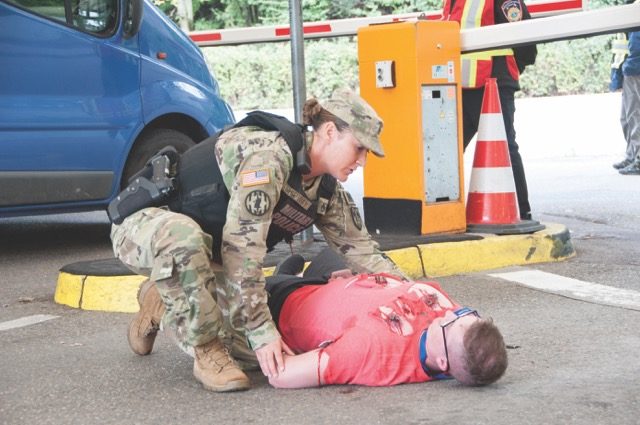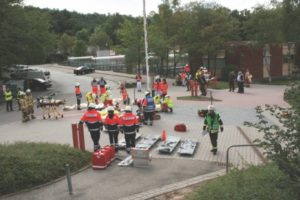
By Larry Reilly
USAG Stuttgart Public Affairs
Dozens of emergency vehicles and personnel converged on Patch Barracks Sept. 16 in response to simulated incidents that resulted in numerous injured and fatal casualties.
The incidents were part of the U.S. Army Garrison Stuttgart’s annual force protection exercise that not only enabled first responders from the garrison, but also the local German communities as well, to practice their abilities and skills to react to serious situations, while testing the Stuttgart military community’s resiliency.
The first incident was a simulated explosion at the main gate that required American and German police, fire and medical personnel to secure the area, take care of the injured and shift to an alternate traffic plan to allow emergency vehicles quick access to the affected area.
“The traffic at the Patch main gate backed up quickly after the scenario kicked in and the civilian traffic was rerouted through the K&K gate so the emergency vehicles could respond to the main gate,” said

Shane Crutcher , USAG Stuttgart, director of Emergency Services. “I tip my hat to all the people who were patient through the entire process as there was a period time when both gates were closed”
Once the ambulances got to the explosion site, the medics moved the injured to a secure and safe location where their wounds were treated and they could be transported to local hospitals.
“More than 125 first responders and dozens of emergency vehicles from the surrounding German communities responded to our requests for assistance,” said Chief Karl Doersam, USAG Stuttgart Fire Department. “It was a great opportunity to train with our first responder counterparts from off post in scenarios that could happen.”
Part of the training was to find out how the responders’ from both sides of the fence would react if more than one incident were to occur, so a second incident was triggered before the first scenario was completed.
“We injected a active shooter scenario into the training plan and did so midway through the process of completing the first scenario to find out how the responders would handle two incidents at the same time,” said Robert Dual, USAG Stuttgart Force Protection chief. “The second scenario occurred on the other side of the installation at the school and included volunteer personnel playing the parts of wounded students.”
The school incident required the medical personnel to coordinate their efforts to administer first aid at two locations. It also required the U.S. and the host nation police units to tactically respond to an active shooter situation.
“The shooter incident enabled our Military Police to work in conjunction with German police to track down the active shooters who were moving through the school,” Crutcher said. “To enhance the communication networks between us and the German responders, we set up a joint incident command post with the German host nation personnel and worked through the requirements for each of the scenarios.”
The garrison also set up its emergency operations center at Panzer Kaserne and remained in constant communications with the incident command post receiving situational updates and providing logistical support to those on site as well as informing the Stuttgart community informed.
Following the exercise, participants gathered to talk about the training and compared notes of best practices as well as ways for improvement.
